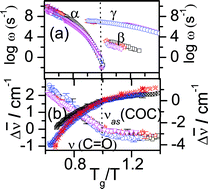The interplay between inter- and intra-molecular dynamics in a series of alkylcitrates
Abstract
The inter- and intra-molecular dynamics in a series of glass-forming alkylcitrates is studied by a combination of Broadband

* Corresponding authors
a
Institute of Experimental Physics I, University of Leipzig, Linnestr. 5, 04103 Leipzig, Germany
E-mail:
Kipnusu@physik.uni-leipzig.de
b Chemical Sciences Division, Oak Ridge National Laboratory, Oak Ridge, Tennessee 37830-6197, USA
The inter- and intra-molecular dynamics in a series of glass-forming alkylcitrates is studied by a combination of Broadband

 Please wait while we load your content...
Something went wrong. Try again?
Please wait while we load your content...
Something went wrong. Try again?
W. K. Kipnusu, W. Kossack, C. Iacob, P. Zeigermann, M. Jasiurkowska, J. R. Sangoro, R. Valiullin and F. Kremer, Soft Matter, 2013, 9, 4681 DOI: 10.1039/C3SM27670H
To request permission to reproduce material from this article, please go to the Copyright Clearance Center request page.
If you are an author contributing to an RSC publication, you do not need to request permission provided correct acknowledgement is given.
If you are the author of this article, you do not need to request permission to reproduce figures and diagrams provided correct acknowledgement is given. If you want to reproduce the whole article in a third-party publication (excluding your thesis/dissertation for which permission is not required) please go to the Copyright Clearance Center request page.
Read more about how to correctly acknowledge RSC content.
 Fetching data from CrossRef.
Fetching data from CrossRef.
This may take some time to load.
Loading related content
